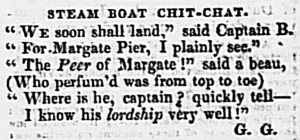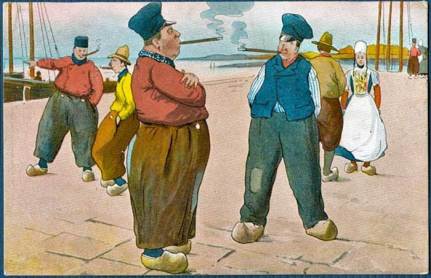One of Dickens’s very first works of fiction, ‘The Boarding House’, makes use of temporary accommodation in Bloomsbury in order to generate narrative scenarios that caricature and subvert the normative marriage plot. Later Bloomsbury boarding-house fiction finds a different tone with which to construct this particular social space in relation to bourgeois marriage conventions, such as the tragicomic in the Burton Crescent scenes in Trollope’s The Small House at Allington (1864) or the naturalistic-tragic in the Gower Place scenes in Gissing’s Workers in the Dawn (1880), but Dickens’s fictionalized house is placed within the generic context of farce. At the same time, while the modes through which this space becomes represented grow darker, modulated over the decades as they are by the development of realism, this slight early story that was anthologized in Sketches by Boz (1836-7) anticipates much of the narrative potential later renderings of the Bloomsbury boarding house would bring to fruition.
The story, which was initially published in two parts, over consecutive months, is structured around two consecutive sets of paying guests residing under one roof in Great Coram Street. Mr and Mrs Tibbs have set up a boarding house there, in order to supplement the pension he receives in reward for the years he served soldiering as a young man. The ‘tolerable house’ they take and furnish is chosen for no apparent reason than the ‘reception of boarders’, and is situated in Bloomsbury ”within ten minutes’ walk of’-everywhere’ so as to make it most attractive to those who might spot the advertisement they have ‘inserted in the morning papers’. The majority of the words that adorn that ad, which boasts a ‘cheerful musical home in a select private family’, are delusive, if not positively fraudulent: the very form of such a document soliciting business, indeed, clearly cancels out its content, in terms of the claims the Tibbses make about their house being a familial home, implicitly sacrosanct from the market. As I have discussed in a previous post, the location of the boarding house in Bloomsbury accentuates its (ideologically, if not actually) contradictory functions as home and business: over the course of the nineteenth century, this West Central district of London suffered a gradual social decline precisely because of its geographical proximity to the City, and the world of commerce, at a time in which the middle class were increasingly defining themselves through the separation of their domestic spaces from spaces of work, and thus deserting Bloomsbury for regions further West.
Initially, as the first chapter narrates, the Tibbs’s first boarders are Mr Hicks and Mr Simpson, two young bachelors, plus one somewhat older single man, Mr Carton; these three are symmetrically balanced by a trio of unattached females, the Maplestone mother and her two daughters, both of whom are on the lookout for a husband. Such a mixture of single people is, of course, standard boarding-house fare, but the canny Mrs Tibbs is aware that managing the liaisons of inmates is a matter of some delicacy. Marriage between these inmates would be a disaster for the Tibbses, and she pronounces a kind of taboo upon the word to her husband: ‘I beg you won’t mention such a thing…A marriage, indeed, to rob me of my boarders – no, not for this world.’ On the other hand, some romantic tension in the air acts as glue, binding her tenants to this specific Bloomsbury house and dissuading them from exchanging it for another nearby, which they might find, in all other respects, equally convenient: ‘A little flirtation…might keep her house full, without leading to any other result.’ To put it another way, Mrs Tibbs encourages intra-house romantic affection because she recognises that it serves as a disguised kind of ‘loyalty bonus’, which can be co-opted and made to work within the commercial nexus she inhabits, whereas marriage proper has a destabilising effect, threatening the house’s profitability by her guests’ dispersal. As we might have guessed from this kind of set-up, a total of three prospective marriages do suddenly ensue, and the tidily profitable full house Mrs Tibbs had been hoping to maintain is broken up with dramatic thoroughness.
As Greg Dart has stressed (2012, p93), the role of the boarding-house keeper problematically blends the familial and the commercial, but in this story Mrs Tibbs is not the most conflicted of the two hosts, as she has no obvious trouble keeping her mind upon the bottom line of the income she secures by seeming to entertain whilst actually impeding her guests’ conjugal ambitions. It is her hen-pecked husband that adopts the role of ‘father’, in agreeing to give away the bride in one of the three clandestine weddings due to take place beyond Mrs Tibbs’s knowledge. After the event, in punishment for this act of rebellion, Tibbs is banished from the marital bedroom to the basement kitchen, and thus sacrifices much of what is left of his own marriage on the altar of vicarious romance. Actually, it is not only the Tibbs’s marriage that is on the rocks in ‘The Boarding House’: all three matches made in the Bloomsbury address in the first half of the story fail, one before the wedding has even taken place:
On the following morning, Mr. Septimus Hicks was united to Miss Matilda Maplesone. Mr. Simpson also entered into a ‘holy alliance’ with Miss Julia; Tibbs acting as father, ‘his first appearance in that character.’ Mr. Calton, not being quite so eager as the two young men, was rather struck by the double discovery; and as he had found some difficulty in getting any one to give the lady away, it occurred to him that the best mode of obviating the inconvenience would be not to take her at all. The lady, however, ‘appealed,’ as her counsel said on the trial of the cause, Maplesone v. Calton, for a breach of promise, ‘with a broken heart, to the outraged laws of her country.’ She recovered damages to the amount of 1,000l. which the unfortunate knocker was compelled to pay. Mr. Septimus Hicks having walked the hospitals, took it into his head to walk off altogether. His injured wife is at present residing with her mother at Boulogne. Mr. Simpson, having the misfortune to lose his wife six weeks after marriage (by her eloping with an officer during his temporary sojourn in the Fleet Prison, in consequence of his inability to discharge her little mantua-maker’s bill), and being disinherited by his father, who died soon afterwards, was fortunate enough to obtain a permanent engagement at a fashionable haircutter’s; hairdressing being a science to which he had frequently directed his attention.
In the following and final second chapter, Mrs Tibbs appears to have plumped for a less risky strategy, and has let her rooms, tellingly, in a much less gender-balanced manner: four single men, plus an invalid with ‘no stomach’ who only surfaces from his room on Sundays, seem unlikely to pose much of a threat to the conjugal status of the only single woman tenant of the house, Mrs Bloss, a recent widow and hypochondriac. The young woman, Agnes, who attends to Mrs Bloss as her companion and nurse, however, attracts the unwanted attention of Mr Tibbs, whose banishment from his wife’s bed appears to have driven him into a pervy middle-life-crisis. In an attempt to prevent another boarding-house break-up, having heard on the grapevine that some sort of unsanctioned relationship between persons unknown might be fermenting, Mrs Tibbs and one of her male guests hide out one night after everyone has apparently gone to bed, in order to catch the romantic culprits at it. Thus emerges a farcical denouement worthy of P. G. Wodehouse. A conversation that is only partially overheard is misunderstood in the fashion of ‘Chinese whispers’, a number of people creep around in the dark hoping to surprise and identify each other, Mr Tibbs (‘clearly under the influence of gin-and-water’) declares to his ‘Hagnes’ how much he hates his wife, shortly before the latter faints, having been herself uncovered and accused in what appears to be a compromising situation alone in the dark with the man with whom she had actually been playing detective. Explanations don’t carry, and the Tibbses separate ‘by mutual consent’; the boarding house, like the marriage, is discontinued, and everyone goes their own way, saving the invalid and Mrs Bloss, who do marry, and ‘revel in retirements: happy in their complaints, their table, and their medicine’.
Dickens continually makes us aware of the Bloomsbury house itself as a kind of agent in the narrative. It intrudes into the lives of the inhabitants, through the kinds of undesired communication its badly constructed walls and ceilings permit. At times, this less-than-solidity, this permeability, is expressed in physical terms – in the ‘wet [that goes] through to the drawing-room ceiling’ after the second-floor front is ‘scrubbed, and washed, and flannelled’ to make way for the new tenant, Mrs Bloss. But mostly, the house enables communication in aural terms, such as the voices ‘distinctly heard’ above one of the guests ‘in the store-room on the first floor, over the leads’, voices that set Mrs Tibbs on the wild goose chase that ends in her downfall. The house militates against the Tibbs’s marriage even as it acts as a sort of matchmaker to the guests, simply by throwing them together, in such an un-domestic ‘entanglement’. Whatever amorous adventures it seems to spark, it does so at the expense of the teleological pay-out readers expect from the conventional marriage plot, however: concocting a couple of marriages that barely get off the ground at all, and severing for good the boarding-house keeper’s own marriage, its only successful partnership seems to rely on the lubrication provided by the couple’s mutual abiding interest in popping pills for imaginary ailments. In the ‘match results’ of Bloomsbury versus the marriage plot, the score looks like 3-1.












